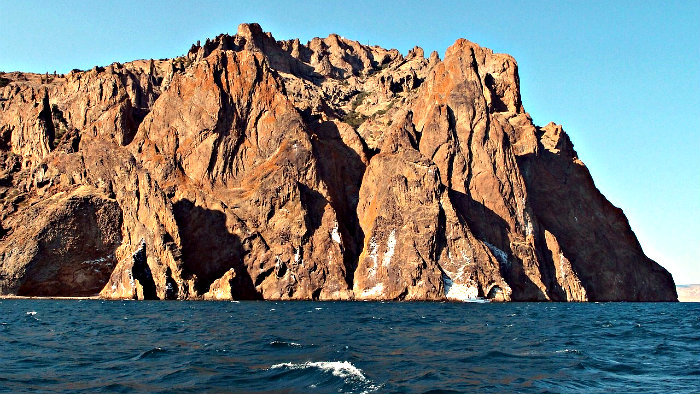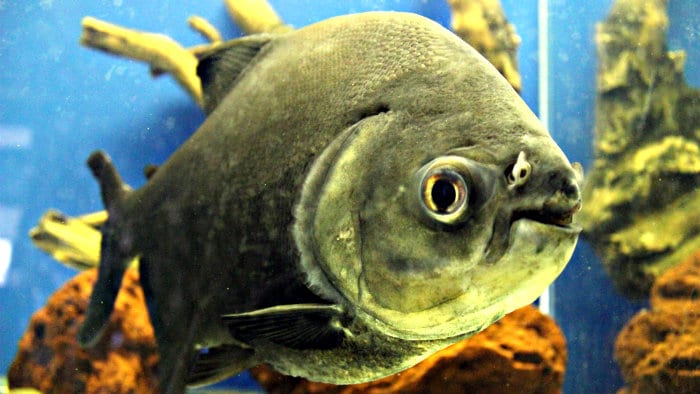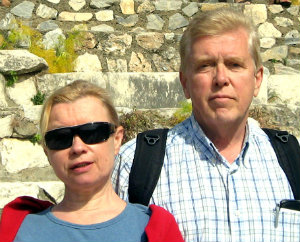The dangerous waters of the world
I was not afraid of swimming in the sea or ocean until a chain of unpleasant occurrences made me a coward I am today. Now, when I go to the beach, I swim only in the shallow water. Why am I such a chicken?
Caught by the storm in the Black Sea

As a child, I have spent many happy summers in the Black Sea area with my parents. We stayed at the beachfront campgrounds, swimming, and snorkeling all day long.
For our honeymoon, Alexander and I went to the Black Sea. We stayed in a hotel in Koktebel, a seaside town on the Crimean Peninsula.
After a few blissful days in Koktebel, we decided to move to the next beach town – Kurortnoe. We could take a bus (14 miles around the north side of the Kara Dag Mountain), but Alexander suggested to get there by swimming around the south side of this mountain. The distance by water was only 6 miles. Kara Dag is a volcanic rock formation, rising over 1,700 feet above the sea level.
The locals told us that some people managed to swim from Koktebel to Kurortnoe in a few hours. We decided that it will be an exciting adventure.
We left early in the morning. The water was warm, the sea – very calm. We had a floating mattress, one pair of flippers, one small backpack, one excellent swimmer (my husband) and one mediocre swimmer (yours truly).
Alexander put his flippers on and we both held to the inflatable mattress. He was in front pulling the mattress with one arm and using another arm for swimming. I was in the back, pushing the mattress forward by vigorously kicking my feet. It was fun! Slowly but surely, we were moving forward.
After a couple of hours, we noticed that the waves started getting bigger. We were not moving as fast as at the beginning. Soon, to our dismay, we realized that we were not moving forward at all.
The wind’s force grew very fast, the waves were getting higher and higher, and they were pushing us closer to the cliffs. While trying our best to move away from them, we saw that we are getting into a dangerous situation: some particularly powerful wave could slam us against the rocks.
I was exhausted and desperately needed to rest. Between the cliffs, we saw a tiny cove with a patch of sand. Three people were sitting there on the rock. We swam towards them. It was a couple with their 10-year-old son. Early in the morning, they swam from Kurortnoe to this cove and planned to return after picnic lunch.
Now, they were afraid to leave this cove because of the deteriorating weather. While we were discussing what to do next, the waves got bigger and threatened to reach our little perch. It looked like we will be stuck on this rock for who knows how long. Or the waves will sweep us into the sea. What should we do?
The men made the decision: we must swim towards Kurortnoe, whatever it takes. Alexander gave one of his flippers to the man, his wife and the son held to our mattress. It was an ordeal. None of us was sure if we will make it to the shore.
It took us the rest of the day to reach the beach in Kurortnoe. I was so dog-tired that I wanted just to lay on the wet sand without moving a limb. It was too late to look for someplace to spend the night. Luckily, our new friends offered to share their food and a tent with us. All our belongings in the backpack were soaking wet.
When we got up late in the morning, still feeling weak from exhaustion, we could hear the roar of the sea. The full-blown storm lasted for three days.
Big waves of the Pacific Ocean

Living close to the ocean in Los Angeles, I was brave enough to go swimming when the waves were not too big.
But one day, the treacherous wave picked me up and slammed me into the sand. I hit the sand so hard – I couldn’t breathe. Luckily, Alexander was next to me. He managed to pull me out of the water.
After this scare, I decided that swimming in the Pacific Ocean is not for me. A few weeks later, we went to the drive-in theatre to watch the movie “Jaws.”
The very first scene scared me senseless. This movie made such an impression on me that I limited my swimming to the quiet lagoon in Marina Del Rey and the pool at the local YMCA.
Box jellyfish in Australia

During our trip to Australia, we came to Cairns, a coastal town favored by tourists for its proximity to the Great Barrier Reef. Early in the morning, our group was taken to Green Island. There, we had two choices: we could spend a whole day on the island, walking on nature trails, going on the glass-bottom boat ride, swimming in the ocean. Or we could buy an optional tour which included taking a boat to the Great Barrier Reef for half-day snorkeling.
I am a big nature lover. If I watch TV (which is very seldom), it is usually some nature program on PBS or a National Geographic show. More than once I watched programs about deadly box jellyfish in Australia. They are so dangerous that their poisonous tentacles can kill you if you do not get immediate medical help.
Snorkeling for the half a day in the water with box jellyfish? Our tour guide told us that the season for the box jellyfish already started. I opted for a safer option – for the whole day on Green Island (but not swimming in the ocean).
We started with a glass-bottom boat ride. Beneath our feet, we could see the corals of different shapes, colors, and sizes. The variety of species was unbelievable, from the enormous gray fish to the small, colorful ones.
Next, we explored the nature trails. Each trail led us from the center of the island to the beach. Green Island is quite small, and we covered all these trails in less than an hour.
Gradually, the day was becoming warmer and warmer. It was the end of December – the middle of the Australian summer. We stopped at the beach at the end of the last nature trail. I needed to cool off. I was envious of people frolicking in the water. A few of them were in wetsuits which were offered for rent at the island shops.
A large noisy group of Japanese tourists was swimming, laughing, splashing each other with water, and of course, taking pictures non-stop. They looked like college kids on vacation. None of them wore a wetsuit.
We decided to go for a quick dip to cool down. We put on our swimsuits and entered the water cautiously. It was a little too cold for me but very refreshing. To be “safe,” I stayed closer to the beach, hoping that Japanese tourists will shield us from the dangerous jellyfish.
I was so nervous that I could not feel relaxed. I stared hard into the water around me, trying to see those deadly creatures. After about 5-10 minutes I was done. I thought that it was better not to test fate and get out of the water unharmed.
Saltwater crocodiles

We spent four days in Cairns. Our hotel was close to the waterfront, which the locals called the Esplanade. We walked there every chance we had.
The beach itself looked very uninviting, though. The water was murky, and the shore was muddy. Also, every 30 yards or so we could see the signs: “Danger!” “ No swimming!” “Saltwater crocodiles!”
These signs helped me understand why the city built a spacious free public pool right on the Esplanade. And why nobody was swimming in the ocean or walking in the sand. Recently, there was a sighting of two crocodiles swimming close to the Esplanade. The video of this event was posted on YouTube.
Scary big fish in Costa Rica

On our first trip to Costa Rica, we took a bus from San Jose to Playa Del Coco. We spent a few nights in a hotel located right on Coco Beach. There was a small open-air seafood restaurant next to our hotel. We ate there every day. The food was delicious and cheap. We especially liked the dish called ‘Pescado Entero’ (the whole fish).
It was fun to sit at the waterfront table, eat the freshly-caught seafood and watch the fishermen pulling their boats out of the water and unloading their catch.
One day, the catch was exceptionally bountiful. Each fish was the size of the man. The fishermen bent in half caring these humongous fish from their boats. The fish’ huge teeth were glistening in the sun. Our daughter suddenly realized that while swimming in the Pacific Ocean she was sharing water with these enormous creatures.
That was the end of her swimming far from the shore. Despite being an excellent swimmer, our poor girl became the same coward as her mother and swam only in the waist-deep water while we stayed at Coco Beach.
What about piranha in this river?

Our itinerary in Ecuador included staying in a fancy hotel in the middle of the Amazon jungle. This hotel was located on the high bank of Napo River, the tributary of the Amazon River.
On our second day there, we were taken a few miles upstream by two motorboats. At the dock, we were met by the guide from the local Indian tribe. The guide distributed high rubber boots. “You’ll need them,” he said smiling. We followed the barefoot guide on the muddy, slippery trail through the jungle while learning about different trees, flowers, and insects.
At the end of this strenuous hike, we were happy to take off our rubber boots which were covered with a thick layer of mud. To our surprise, instead of taking the same motorboats back to the hotel, we were put on two rafts. These rafts were made from tree trunks, which were fastened together by ropes.
They divided us into two equal groups – ten on one raft and ten on another. Our tour director was on one raft; the Indian guide was on the other. The two motorboats were following close by. The rafts had to take us down the river, back to our hotel.
For some reason, my raft became partially submerged. All eleven of us were sitting in a few inches of water. I saw that people on the raft in front of us were all dry. What’s wrong? Is our float safe? Or was it made with fewer tree trunks than the other one?
I have read that the Napo River had piranha. TV shows about the piranha swarming over some poor animal came to mind. I also knew that the Amazon basin had many dangerous parasites which can enter the human body through the skin. And what about the bloodsucking leeches?
I tried my best to remove all these negative thoughts from my mind. I decided to enjoy the pleasant ride (even if a very wet one) and the views of the jungle on both sides of the river.
Somehow, I ended up loving this unusual and exotic ride on the jungle river in Amazon. Our raft did not overturn, nobody fell into the water, no one was attacked by the piranha, and we all returned to our hotel in one (wet but happy) piece.
Are you a coward like me?
Almost every day you can read in the paper, on the Internet, or watch on TV the stories about people getting into dangerous situations on the water.
It’s better to be cautious than careless when one is going into the water. If you are a tourist, always ask locals about the safe places for swimming. Watch for warning flags and rip currents on the beaches. Stay sober. Do not go into a river or a lake in the tropics – because of possible dangers like crocodiles or harmful parasites.
Are you a “coward” like me? What about your fears when you face the “dangerous waters of the world?”


Recent comments